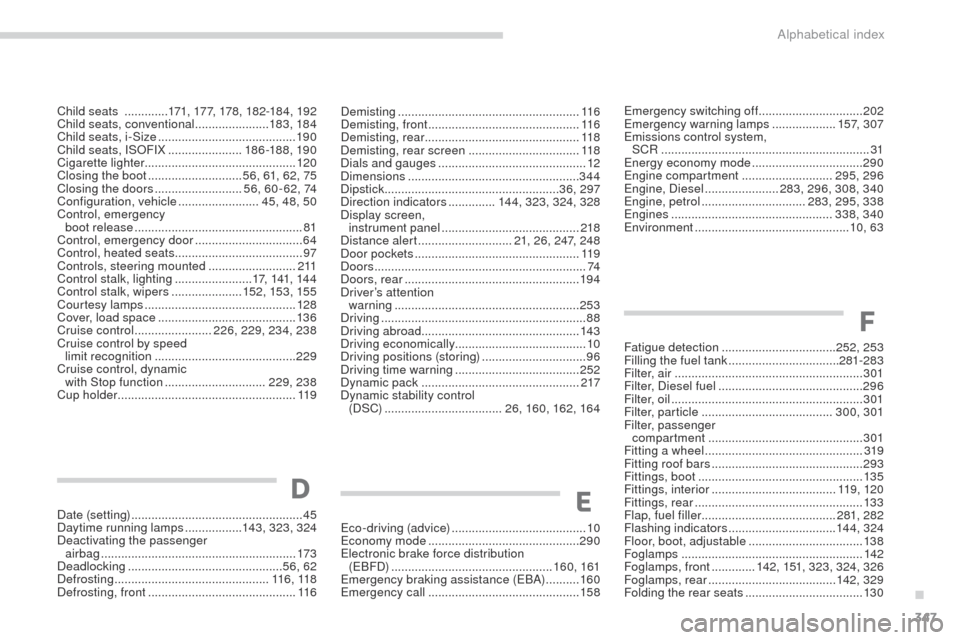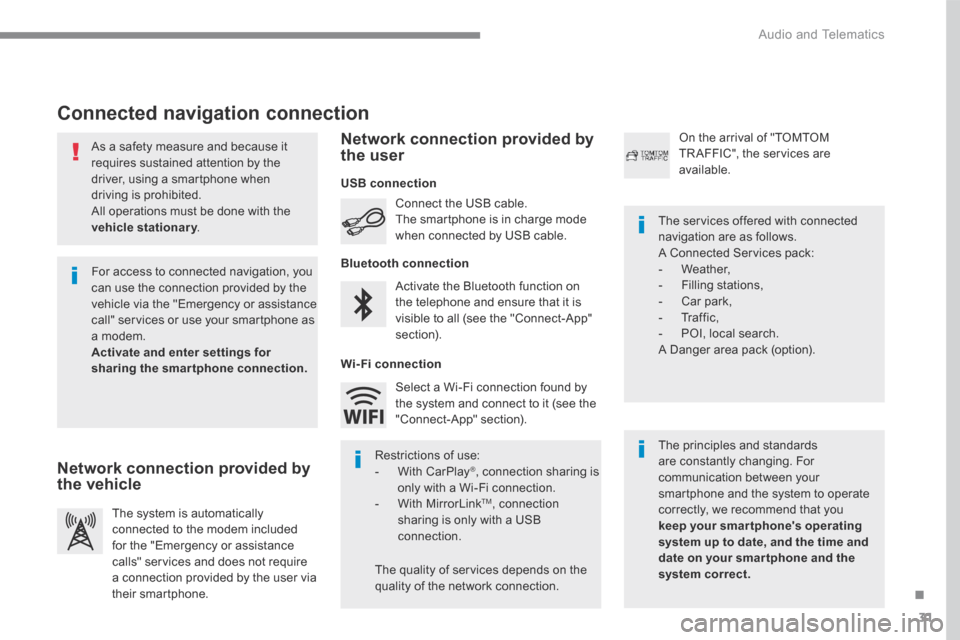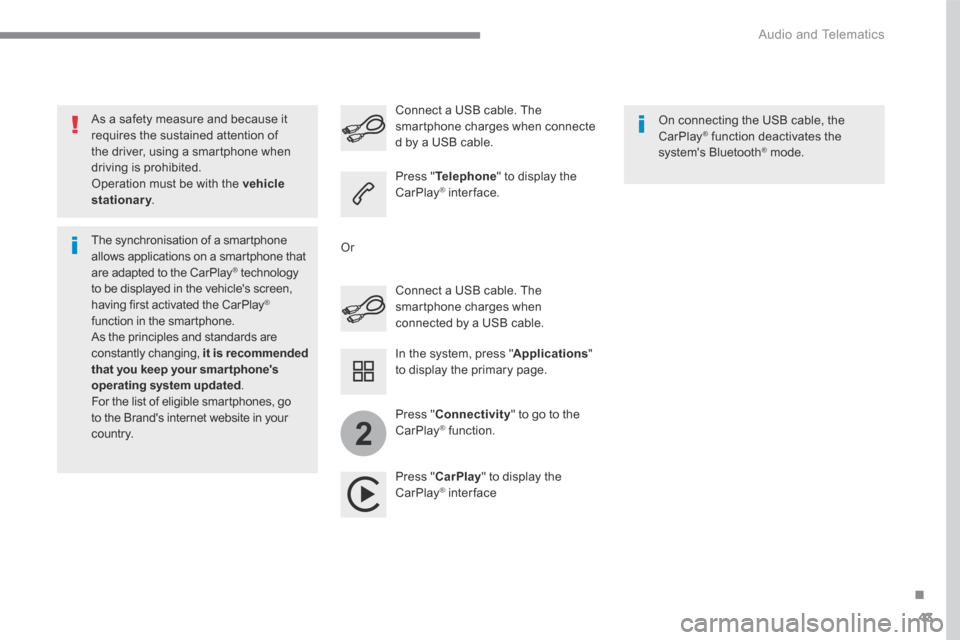2017 Peugeot 3008 Hybrid 4 ECO mode
[x] Cancel search: ECO modePage 341 of 566

339
3008-2_en_Chap09_caracteristiques_ed01-2016
Petrol weights and towed loads (in kg)
The GTW and towed load values indicated are valid up to a maximum altitude of 1 000 metres; the towed load mentioned must be reduced by 10 % for
each additional 1 000 metres of altitude.
When towing the maximum authorised speed is reduced (comply with the legislation in force in your country).
High ambient temperatures may result in a reduction in the per formance of the vehicle to protect the engine; if the ambient temperature is above 37 °C,
limit the towed load.Petrol engine
1.2 litre PureTech 130 S&S 1.6 litre THP 150 1.6 litre THP 160 1.6 litre THP 165
S&S
Gearbox Manual
(6- speed) E AT 6
automatic (6- speed) E AT 6
automatic (6- speed) E AT 6
automatic (6- speed) E AT 6
automatic (6- speed)
Model code:
MR... M4... HNYH/S -
HNYH/1S HNY W/S -
HNY W/1S 5FEA
5FMA5GZW/S
Unladen weight 1 250 - 1 254---1 300
Kerb weight* 1 325 - 1 329---1 375
Gross vehicle weight (GV W) 1 910---1 950
Gross train weight (GTW)
on a 12% gradient 3 310 - 3 210
---3 500
Braked trailer (within the GTW limit)
on a 10% or 12% gradient 1 400 - 1 300
---1 550
Unbraked trailer 660---685
Recommended nose weight 70---70
* The kerb weight is equal to the unladen weight + driver (75 kg).
9
Technical data
Page 344 of 566

342
3008-2_en_Chap09_caracteristiques_ed01-2016
Diesel weights and towed loads (in kg)
The GTW and towed load values indicated are valid up to a maximum altitude of 1 000 metres; the towed load mentioned must be reduced by 10 % for
each additional 1 000 metres of altitude.
When towing, the maximum authorised speed is reduced (comply with the legislation in force in your country).
High ambient temperatures may result in a reduction in the per formance of the vehicle to protect the engine; if the ambient temperature is above 37 °C,
limit the towed load.Diesel engine
1.6 litre BlueHDi
100 S&S 1.6 litre BlueHDi 115 S&S
1.6 litre BlueHDi 120 S&S
Gearbox Manual
(5 -speed ) Manual
(6- speed) E AT 6
automatic (6- speed) Manual
(6- speed) E AT 6
automatic (6- speed)
Model code:
MC... BHY6/SBHXH/S -
BHXH/1S BHXW/SBHZH/S -
BHZH/1S BHZW/S
Unladen weight -1 300 - 1 304 1 3151 300 - 1 304 1 315
Kerb weight* -1 375 - 1 379 1 390 1 375 - 1 379 1 390
Gross vehicle weight (GV W) -1 970 - 1 980 1 990 1 970 - 1 980 1 990
Gross train weight (GTW)
on a 12% gradient -
3 470 - 3 380 3 290 3 470 - 3 380 3 290
Braked trailer (within the GTW limit)
on a 10% or 12% gradient -
1 500 - 1 400 1 300 1 500 - 1 400 1 300
Unbraked trailer -685 695685695
Recommended nose weight -70 707070
* The kerb weight is equal to the unladen weight + driver (75 kg).
Technical data
Page 345 of 566

343
3008-2_en_Chap09_caracteristiques_ed01-2016
The GTW and towed load values indicated are valid up to a maximum altitude of 1 000 metres; the towed load mentioned must be reduced by 10 % for
each additional 1 000 metres of altitude.
When towing, the maximum authorised speed is reduced (comply with the legislation in force in your country).
High ambient temperatures may result in a reduction in the per formance of the vehicle to protect the engine; if the ambient temperature is above 37 °C,
limit the towed load.Diesel engine
2.0 litre BlueHDi 150
2.0 litre BlueHDi 150 S&S 2.0 litre BlueHDi 180 S&S
GearboxManual
(6- speed) EAT6 automatic
(6- speed) Manual
(6- speed) EAT6 automatic
(6- speed)
Model code:
MJ... -
-AHRH/S
AHSH/S
AHXH/S AHWW/S
Unladen weight --1 425 1 465
Kerb weight* --1 500 1 540
Gross vehicle weight (GV W) --2 050 2 090
Gross train weight (GTW)
on a 12% gradient -
-3 700 3 730
Braked trailer (within the GTW limit)
on a 10% or 12% gradient -
-1 650 1 640
Unbraked trailer --74 5 750
Recommended nose weight --70 70
* The kerb weight is equal to the unladen weight + driver (75 kg).
Diesel weights and towed loads (in kg)
9
Technical data
Page 349 of 566

347
3008-2_en_Chap11_index-alpha_ed01-2016
Demisting ......................................................11 6
Demisting, front ............................................. 11 6
Demisting, rear
.............................................. 11
8
Demisting, rear screen
.................................118
Dials and gauges
............................................ 12
Dimensions
................................................... 344
Dipstick
................
.................................... 36, 297
Direction indicators
..............14 4, 323 , 324, 328
Display screen, instrument panel
...............................
..........218
Distance alert
............................ 21, 26 , 247 , 248
Door pockets
................................................. 11
9
Doors
............................................................... 74
Doors, rear
.................................................... 19 4
Driver’s attention warning
...............................
........................253
Driving
............................................................. 88
Driving abroad ............................................... 143
Driving economically ....................................... 10
Driving positions (storing)
...............................96
Driving time warning
..................................... 252
Dynamic pack
..............................
.................217
Dynamic stability control (DSC)
................................... 26, 160 , 162, 16 4 Emergency switching off ...............................
2 02
Emergency warning lamps ................... 15
7, 307
Emissions control system, SCR
..............................................................31
Energy economy mode
.................................290
Engine compartment
...........................295, 296
Engine, Diesel
...................... 28
3, 296 , 308 , 340
Engine, petrol
...............................283, 295 , 338
Engines
................................................338, 340
Environment
...............................
...............10, 63
Child seats
.............
17
1
, 17 7 , 178 , 182-18 4 , 192
Child seats, conventional
...................... 183, 18 4
Child seats, i-Size
...............................
.......... 19 0
Child seats, ISOFIX
...................... 18
6 -188 , 19 0
Cigarette lighter ............................................. 120
Closing the boot
............................ 56, 61 , 62 , 75
Closing the doors
.......................... 56, 60-62 , 74
Configuration, vehicle
........................ 45, 48 , 50
Control, emergency boot release
.................................................. 81
Control, emergency door
................................ 64
Control, heated seats
...................................... 97
Controls, steering mounted
.......................... 2 11
Control stalk, lighting
....................... 17,
141 , 14 4
Control stalk, wipers
..................... 152, 153 , 155
Courtesy lamps
............................................. 128
Cover, load space
......................................... 13
6
Cruise control
....................... 2
26 , 229 , 234 , 238
Cruise control by speed limit recognition
.......................................... 229
Cruise control, dynamic with Stop function
.............................. 229, 238
Cup holder
...............................
...................... 11 9
F
Fatigue detection .................................. 252, 253
Filling the fuel tank ................................. 28
1-283
Filter, air
...............
......................................... 301
Filter, Diesel fuel
........................................... 296
Filter, oil
......................................................... 301
Filter, particle
....................................... 300, 301
Filter, passenger compartment
.............................................. 3
01
Fitting a wheel
...............................
................319
Fitting roof bars
............................................. 293
Fittings, boot
................................................. 13
5
Fittings, interior
..................................... 11 9, 120
Fittings, rear
...............................
...................13 3
Flap, fuel filler
...............................
.........281, 282
Flashing indicators
................................ 14 4, 324
Floor, boot, adjustable
..................................13 8
Foglamps
...................................................... 142
Foglamps, front
.............142, 151 , 323 , 324, 326
Foglamps, rear
...................................... 142, 329
Folding the rear seats
...................................13 0
D
Date (setting) ............................... ....................45
Daytime running lamps .................143, 323 , 324
Deactivating the passenger airbag
.......................................................... 17
3
Deadlocking
.............................................. 56, 62
Defrosting
.............................................. 11 6, 118
Defrosting, front
............................................ 11
6E
Eco-driving (advice) ........................................ 10
Economy mode ............................................. 290
Electronic brake force distribution (EBFD)
................................................ 160, 161
Emergency braking assistance (EBA)
.......... 16
0
Emergency call
............................................. 15
8
.
Alphabetical index
Page 361 of 566

1
.
Audio and Telematics
Transversal-Peugeot_en_Chap01_NAC-2-2-0_ed01-2016
PEUGEOT Connect Nav
GPS satellite navigation - Applications - Multimedia audio - Bluetooth ® GPS satellite navigation - Applications - Multimedia audio - Bluetooth ® GPS satellite navigation - Applications - Multimedia audio - Bluetooth telephone ® telephone ®
Contents First steps 2
Steering mounted controls 5
Menus 6
Voice commands 8
Navigation 14
Connected navigation 30
Applications 40
Radio Media 56
Telephone 68
Settings 80
Frequently asked questions 90
The system is protected in such a way that it will only operate in your vehicle. Displaying of the Energy Economy Mode message signals that a change to standby is imminent.
The different functions and settings described vary according to the version and configuration of your vehicle.
The link below gives access to OSS (Open Source Software) codes for the system. http://www.psa-peugeot-citroen.com/oss
As a safety measure and because it requires sustained attention by the driver, the pairing of a Bluetooth mobile telephone with the Bluetooth hands-free system of your audio system must be done with the vehicle stationaryand the ignition on.
Page 368 of 566

8
Audio and Telematics
Transversal-Peugeot_en_Chap01_NAC-2-2-0_ed01-2016
Voice commands
First steps Steering mounted controls Information - Using the system
Press the Push To Talk button and tell me what you'd like after the tone. Remember you can interrupt me at any time by pressing this button. If you
press it again while I'm waiting for you to speak, it'll end the conversation. If you need to start over, say "cancel". If you want to undo something, say "undo". And to get information and tips at any time, just say "help". If you ask to me do something and there's some information missing that I need, I'll give you some examples or take you through it step by step. There's more information available in "novice" mode. You can set the dialogue mode to "expert" when you feel comfortable.
To ensure that voice commands are always recognised by the system, please observe the following recommendations: - speak in a normal tone without breaking up words or raising your voice. - always wait for the "beep" (audible signal) before speaking. - for best operation, it is recommended that the windows and opening roof be closed to avoid extraneous interference (according to version). - before making a voice command, ask other passengers to not speak.
The voice commands, with a choice of 12 languages (English, French, Italian, Spanish, German, Dutch, Portuguese, Polish, Turkish, Russian, Arabic, Brazilian), are made using the language previously chosen and set in the system.
The voice commands in Arabic for: "Navigate to address" and "Display POI in the city", are not available.
Alternative synonyms can be used for some voice commands. E.g. Guide to / Navigate to / Go to / ...
Example of a "voice command" for navigation: "Navigate to address 11 Regent Street, London" .
Example of a "voice command" for the radio and media: "Play ar tist Madonna" .
Example of a "voice command" for the telephone: "Call David Miller" .
Pressing this button activates the voice commands function.
Page 391 of 566

31
.
Audio and Telematics
Transversal-Peugeot_en_Chap01_NAC-2-2-0_ed01-2016
As a safety measure and because it requires sustained attention by the driver, using a smartphone when driving is prohibited. All operations must be done with the
vehicle stationary . vehicle stationary . vehicle stationary
Connected navigation connection
The principles and standards are constantly changing. For communication between your smartphone and the system to operate correctly, we recommend that you keep your smar tphone's operating system up to date, and the time and date on your smar tphone and the system correct.
The services offered with connected navigation are as follows. A Connected Services pack: - Weather, - Filling stations, - Car park, - Traffic, - POI, local search. A Danger area pack (option).
Activate the Bluetooth function on the telephone and ensure that it is visible to all (see the "Connect-App" section).
Connect the USB cable. The smartphone is in charge mode when connected by USB cable.
The system is automatically connected to the modem included for the "Emergency or assistance calls" services and does not require a connection provided by the user via
their smartphone.
On the arrival of "TOMTOM TR AFFIC", the services are available.
For access to connected navigation, you can use the connection provided by the vehicle via the "Emergency or assistance call" services or use your smartphone as a modem. Activate and enter settings for sharing the smartphone connection.
Restrictions of use: - With CarPlay ® , connection sharing is only with a Wi-Fi connection. - With MirrorLink TM , connection sharing is only with a USB connection.
The quality of services depends on the quality of the network connection.
Select a Wi-Fi connection found by the system and connect to it (see the "Connect-App" section).
USB connection
Network connection provided by the vehicle
Network connection provided by the user
Bluetooth connection
Wi-Fi connection
Page 403 of 566

43
.
2
Audio and Telematics
Transversal-Peugeot_en_Chap01_NAC-2-2-0_ed01-2016
As a safety measure and because it requires the sustained attention of the driver, using a smartphone when driving is prohibited. Operation must be with the vehicle stationary . stationary . stationary
The synchronisation of a smartphone allows applications on a smartphone that are adapted to the CarPlay ® technology ® technology ®
to be displayed in the vehicle's screen, having first activated the CarPlay ® function in the smartphone. As the principles and standards are constantly changing, it is recommended that you keep your smar tphone's operating system updated . For the list of eligible smartphones, go to the Brand's internet website in your c o unt r y.
Connect a USB cable. The smartphone charges when connected by a USB cable.
Connect a USB cable. The smartphone charges when connecte d by a USB cable.
Press " Telephone " to display the CarPlay ® inter face. ® inter face. ®
Press " CarPlay " to display the CarPlay ® inter face ® inter face ®
On connecting the USB cable, the CarPlay ® function deactivates the ® function deactivates the ®
system's Bluetooth ® mode. ® mode. ®
In the system, press " Applications " to display the primary page.
Or
Press " Connectivity " to go to the CarPlay ® function. ® function. ®